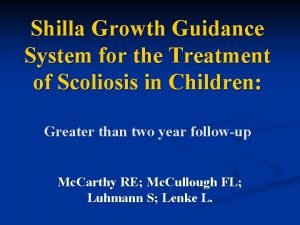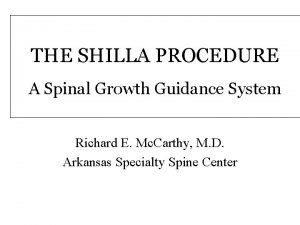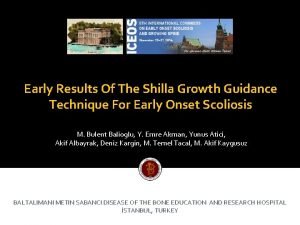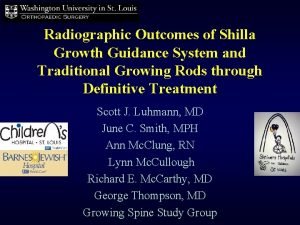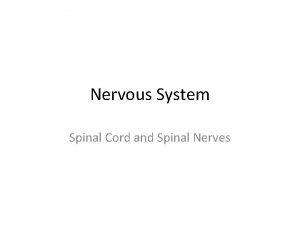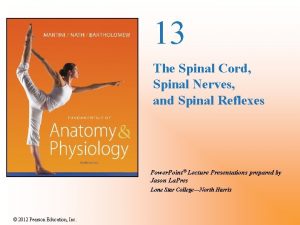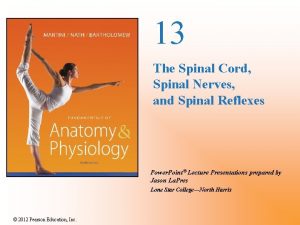THE SHILLA PROCEDURE A Spinal Growth Guidance System















- Slides: 15

THE SHILLA PROCEDURE A Spinal Growth Guidance System Richard E. Mc. Carthy, M. D. Arkansas Specialty Spine Center

Spinal Deformities in Children • Types of Solutions • Problems – Correction/Fusion - - - – Convex tethering/partial fusion - - - – Loss of growth – Partial correction/ partial growth loss – “Growing rods” - - - - – Repeat trips to OR/ growth accommodating goal is fusion

Shilla Procedure • Growth is encouraged and guided • Corrects the 3 D spinal deformities – Fuses apex only • Ultimate goal is spinal motion – Rod removal at maturity – Facet preservation 850

Scoliosis • Infantile and Juvenile – Multiple types 720 *Not inclusive of chest wall deformities

Shilla Procedure: 86º • Correction focused at apex derotate spine – Fixed head pedicle screws fix to rod – Apex fused – over 2 -4 levels • Growth guidance screws at ends of curve – Screws slide along rods with growth

Method • Growth guidance screws – Fix to bone; not to rod – Capture the rod but allow it to slide – Multiple planes of screw motion decrease stress on bone fixation Polyaxial Screw Snap Off Fixation Plug

Surgical Strategy 1) Flexibility films determine if anterior apical release necessary – staged 2) Goal: Correct apex to normal alignment in all planes 3) Preoperative planning for screw placement - blueprint 4) Leave rods long for growth

Surgical Techniques • Subperiosteal exposure of apex only • Subfascial exposure for growing screws • Thoracoplasty – graft harvest and deformity correction

Surgical Techniques • Growing screws placed with C-arm radiographs • Rod and apical screw derotation

Background Research • Laboratory cycling – 1 million cycles – No implant failures – Metal filings

Background Research • Animal Research – goats – All grew – No apical stenosis – Joints maintained 10 weeks 22 weeks

Index Patient • Infantile Idiopathic Scoliosis • 2+10 years 860 Preop Flexibility 6 wks postop 2 yrs postop

Results - early • Twenty patients – 15 pts-Little Rock – Richard E. Mc. Carthy – 5 pts- St. Louis - Lawrence Lenke, Scott Luhmann • Age 6+1 yrs (range 2+10 to 11 yrs) • Multiple diagnoses (neuromuscular, congenital, idiopathic) • Scoliosis 71. 50 240 Corrected to • Two yr follow-up: 3 pts. • None have reached maturity 720

Problems • Two infections – I and D • Revisions – Implant prominence (5) (2 temporary rod removal) – Rod breakage (1) – Screw pullout (1) – Growth off ends of rods (1) – Inability to control: • Pelvic obliquity – SMA pt. (1) • Double major curve – idiopathic pt. (1)

Conclusion We are reporting early results on a challenging group of patients who have undergone a new surgical approach that allows them to be brace free, able to grow, without repeated spinal lengthenings.
 Shilla development
Shilla development Shilla procedure
Shilla procedure Wasit pssi
Wasit pssi Shilla procedure
Shilla procedure Art-labeling activity figure 13.6a (1 of 2)
Art-labeling activity figure 13.6a (1 of 2) Figure 13-2 spinal nerves labeled
Figure 13-2 spinal nerves labeled Lateral pectoral nerve
Lateral pectoral nerve Rubrospinal
Rubrospinal Lingualized occlusion vs balanced occlusion
Lingualized occlusion vs balanced occlusion What is the purpose of direct and indirect guidance
What is the purpose of direct and indirect guidance Plant growth index
Plant growth index Primary growth and secondary growth in plants
Primary growth and secondary growth in plants Carothers equation
Carothers equation Primary growth and secondary growth in plants
Primary growth and secondary growth in plants Vascular ray
Vascular ray Geometric growth graph
Geometric growth graph
